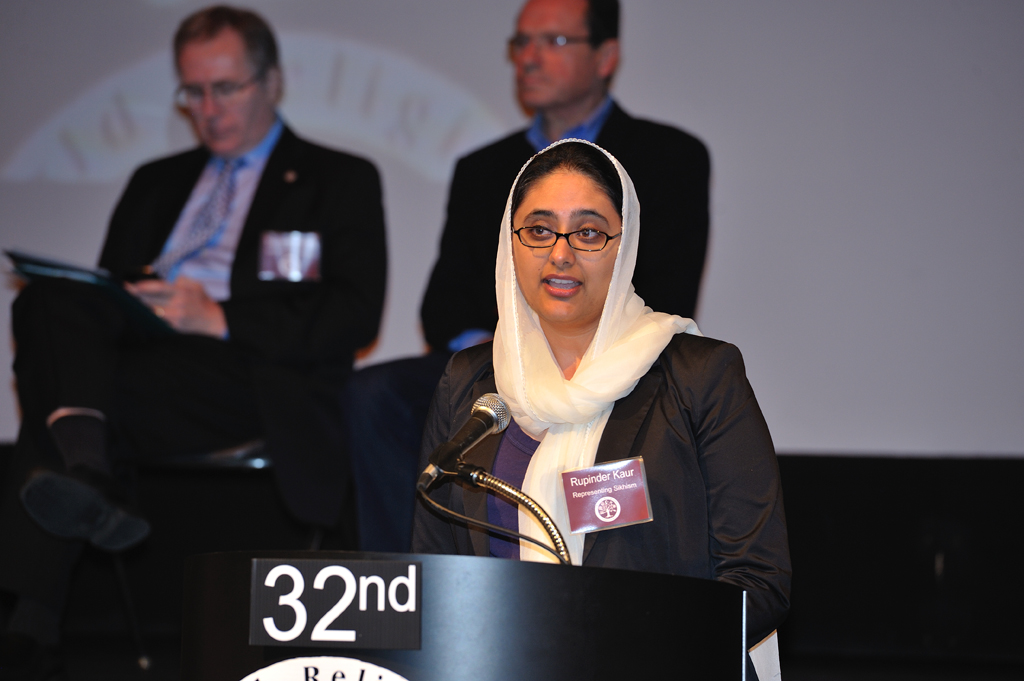Idea of an Ideal Government
Sikh Perspective
by Rupinder Kaur
Sikh Scholar and Press secretary for the NDP

Abstract of Theme Speech
The teachings of any religion guides one through our daily lives – leading us in actions, directing our thoughts, showing us the right path and deterring us away from the wrong. When following our faith, we become an ideal individual. So when faith provides insight on how to govern ourselves – we can extend that argument and make the case that faith also provides us the tools on how to create an ideal government.
For me, my Sikh faith teaches that I am a sovereign, independent individual; however, I make up part of the universal collective. That means, although I may think and act on my own, those thoughts and actions may affect those around me. If they negatively impact on someone else, that means I’m not following the principles of my faith.
Three basic and core rules in the Sikh faith are: kirit karna (work hard and honestly), vand chakna (share your wealth), and naam japna (reflect on the Creator).
These three simple tenets are like the “golden rules” and I’m sure a variation is practiced by many of us, regardless of faith tradition or culture.
In any government, there are political parties that are based on ideals – it forms their values and shapes their aspirations. We vote for a political party or candidate that best reflects our personal beliefs. One ideal we all strive for is fairness and it is a concept all democratic governments try to model themselves
on.
In the grand scheme of things, the ideal government runs smoothly and the management of issues like justice, taxation, even environmental policy could be based on theology.
In the Sikh holy text, the Guru Granth Sahib, the concept of an ideal government is described in the metaphor of a city called “Begumpura” and it defines the epitome of a good city according to Sikhism. The challenge for the good city would be to create a more equitable society with opportunities for all and in which citizens are spiritually greedy rather than materially so. Secondly, in the spirit of selfless service, ordinary citizens would be challenged to work with the less-fortunate, under-privileged or marginalized citizens. Thirdly, urban regeneration should not just be about cleaning streets, building bigger shopping malls and mansions should also reflect on the regeneration of the human spirit with a focus on positive development, sustainability and reducing our negative impact on the environment.
The citizens under an ideal government will play a vital role in its proper functioning and success. However, every successful organization has a skilled and able leadership team and this is no different for a city or government. The Sikh philosophy stresses that leaders should have the qualities of humility and selflessness, they should be servants of the people prepared to work tirelessly for the betterment of society. The Guru Granth Sahib describes the qualities of a leader:
Only he should sit on the throne,
who is worthy of it,
And who has realized the Guru's word and silenced the five desires
(lust, anger, greed, attachment and ego).
Adi Granth, p. 1039
Members of the ideal government must be God-centred people, who strive to maintain the highest moral standards and who wish to carry out their duties, not for ambition, wealth and power, but for a real desire to serve the people and leave the world in a better state than when they found it.
The architecture of a city, its layout and environment shape our thought processes and should be a reflection of the character and spirit of the city and government.
In Sikhism there is a perfect example of how architecture can represent the qualities and ideals of a community and which can be extended to urban planning for the good city. This of course is Harimandar Sahib, or the “Golden Temple” as it is commonly known. It symbolizes a synthesis of styles but ultimately has a style of its own. It represents the eclectic nature of the Sikh faith and the bringing together of people from all faiths under the umbrella of the Oneness of God. A single pathway or bridge leads the worshipper from the entrance gate of the Golden Temple complex to the holy sanctorum of the temple and denotes the connection between worldly and spiritual affairs. The actual shrine is kept at a lower level than the surrounding buildings symbolizing humility, an example to the leadership of a good city. The temple structure stands within a pool of water which gives out the effect of peace, serenity and contemplation, a cue for providing attractive public spaces in a good city.
The temple itself has four entrances signifying that, like a good city, it is open to all without distinction. At the core of the temple is the sacred scripture and its recitation resonates outwards to all who wish to hear.
An ideal government operates to meet the needs of all its citizens. It is not a static or constant model but changes with time, progress and circumstance. For Sikhs, there are key components for an ideal government which will stand the test of time and therefore should be ingrained in the social fabric. The city must be a beacon of truth and justice and incorporate the ideals of equality, diversity and selfless service. Employment opportunities, education and public services from health to transit, must be accessible to all. Most importantly, for Sikhs an ideal government represents a paradigm for the city of
God.


